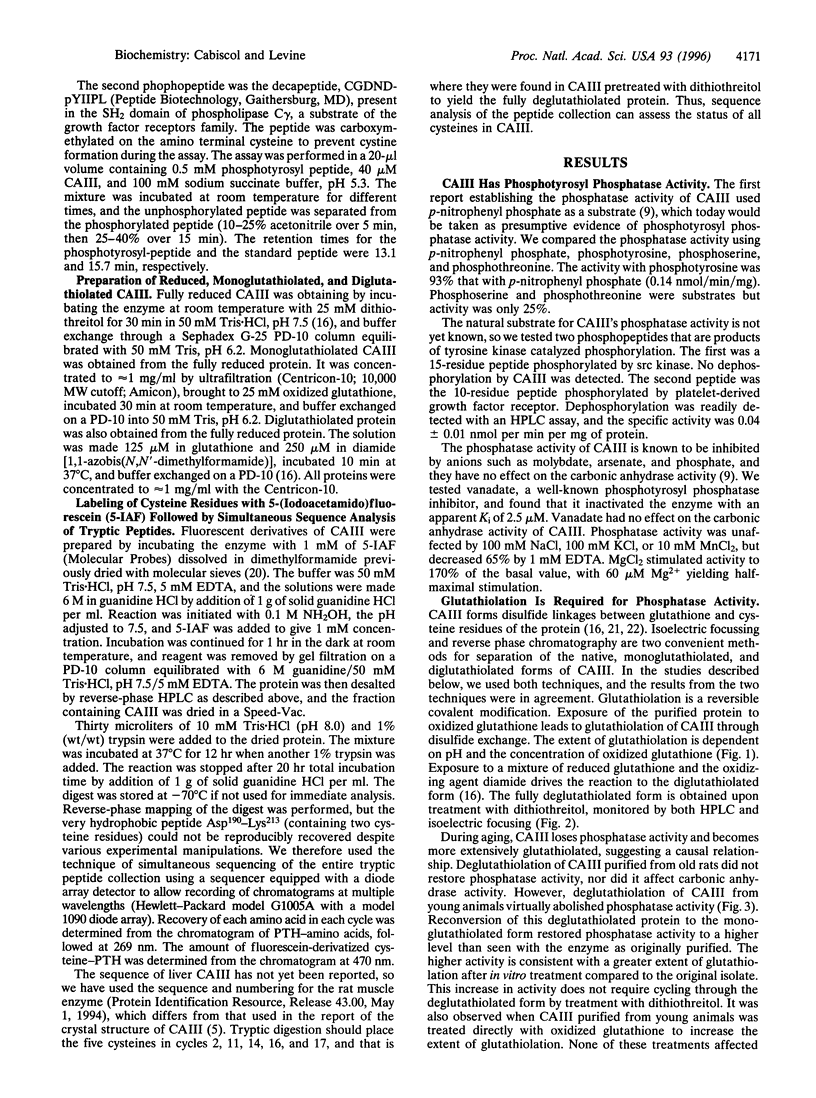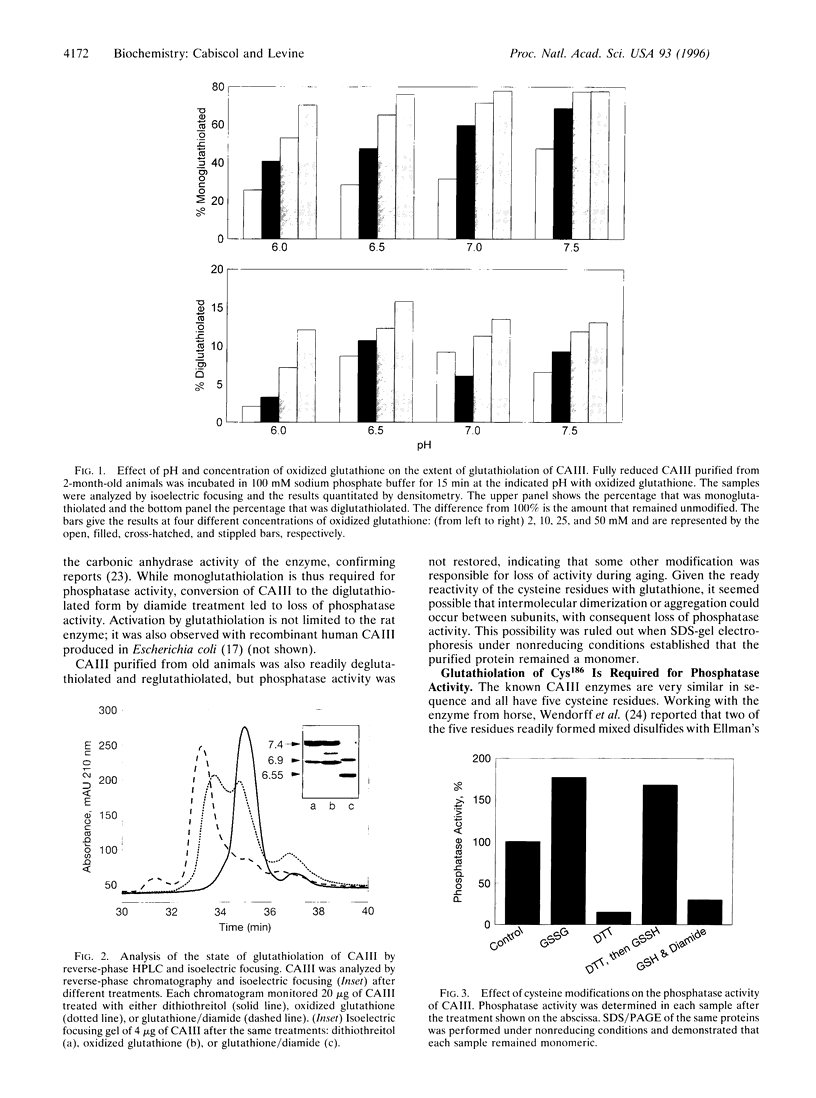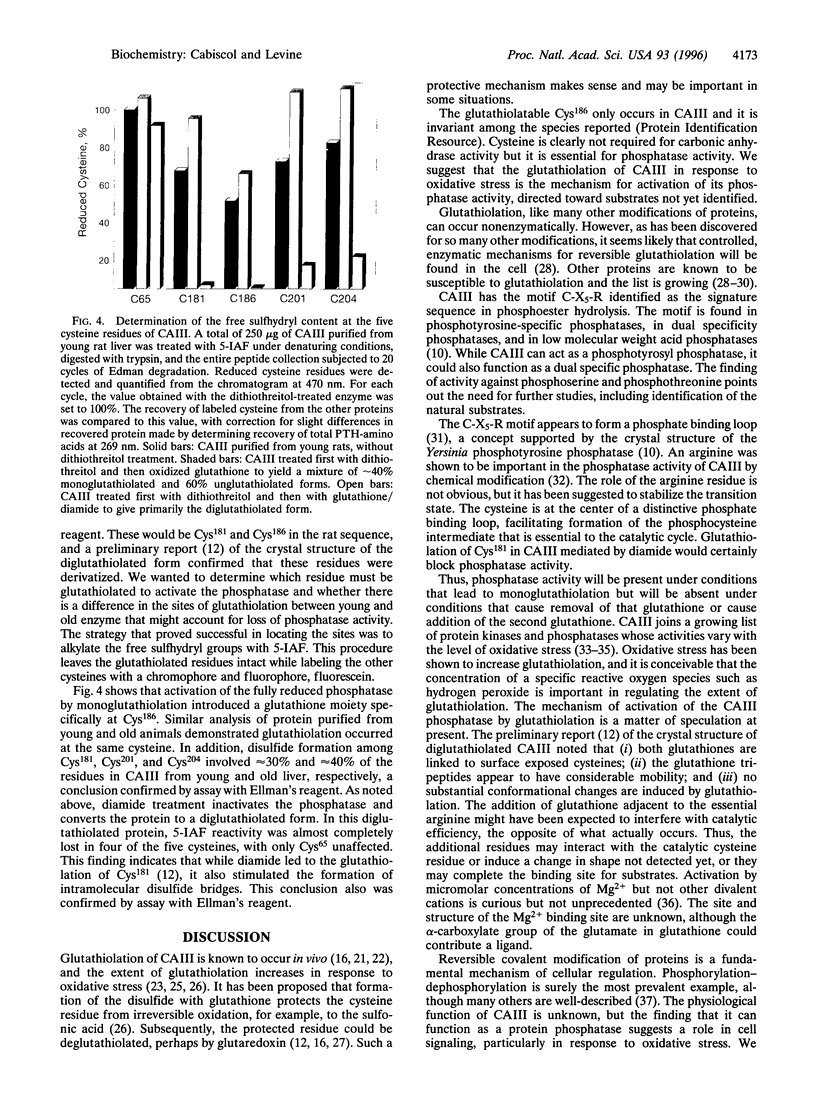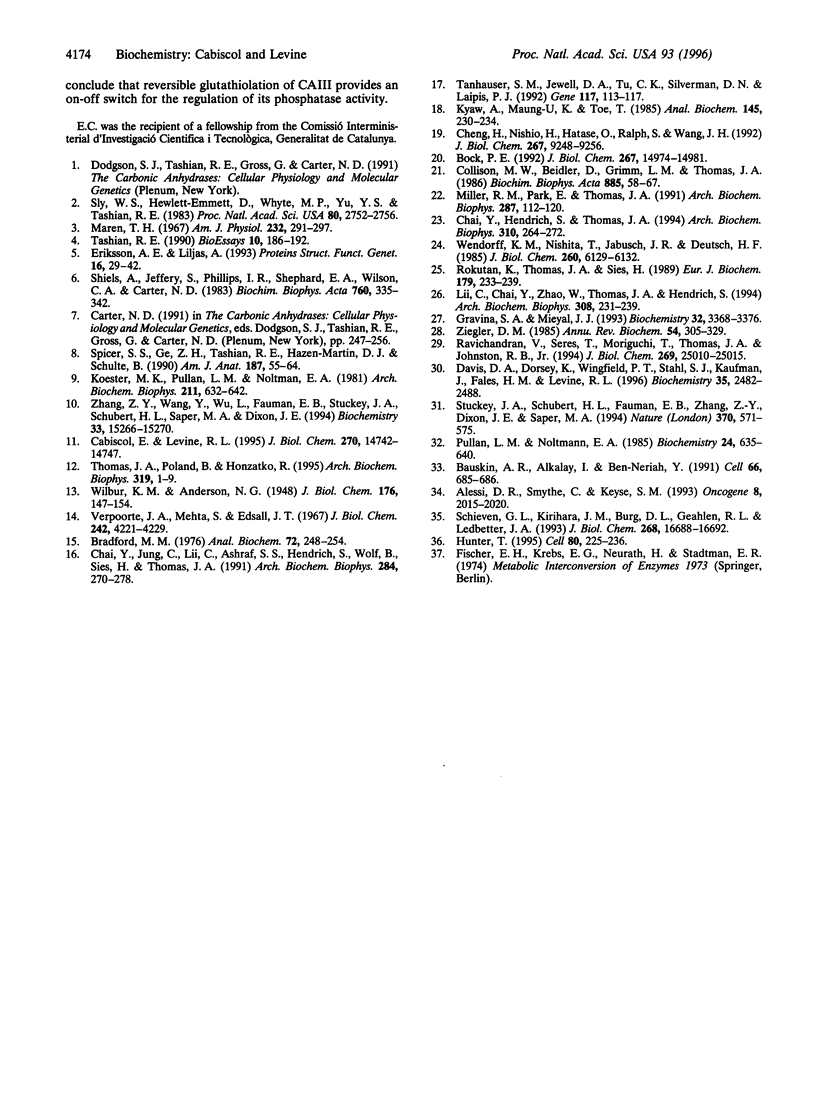Abstract
Carbonic anhydrase isozyme III (CAIII) is unique among the carbonic anhydrases because it demonstrates phosphatase activity. CAIII forms a disulfide link between glutathione and two of its five cysteine residues, a process termed S-glutathiolation. Glutathiolation of CAIII occurs in vivo and is increased during aging and under acute oxidative stress. We show that glutathiolation serves to reversibly regulate the phosphatase activity of CAIII. Glutathiolation of Cys-186 is required for phosphatase activity, while glutathiolation of Cys-181 blocks activity. Phosphotyrosine is the preferred substrate, although phosphoserine and phosphothreonine can also be cleaved. Thus, glutathiolation is a reversible covalent modification that can regulate CAIII, a phosphatase that may function in the cellular response to oxidative stress.
Full text
PDF




Images in this article
Selected References
These references are in PubMed. This may not be the complete list of references from this article.
- Alessi D. R., Smythe C., Keyse S. M. The human CL100 gene encodes a Tyr/Thr-protein phosphatase which potently and specifically inactivates MAP kinase and suppresses its activation by oncogenic ras in Xenopus oocyte extracts. Oncogene. 1993 Jul;8(7):2015–2020. [PubMed] [Google Scholar]
- Bauskin A. R., Alkalay I., Ben-Neriah Y. Redox regulation of a protein tyrosine kinase in the endoplasmic reticulum. Cell. 1991 Aug 23;66(4):685–696. doi: 10.1016/0092-8674(91)90114-e. [DOI] [PubMed] [Google Scholar]
- Bock P. E. Active-site-selective labeling of blood coagulation proteinases with fluorescence probes by the use of thioester peptide chloromethyl ketones. II. Properties of thrombin derivatives as reporters of prothrombin fragment 2 binding and specificity of the labeling approach for other proteinases. J Biol Chem. 1992 Jul 25;267(21):14974–14981. [PubMed] [Google Scholar]
- Bradford M. M. A rapid and sensitive method for the quantitation of microgram quantities of protein utilizing the principle of protein-dye binding. Anal Biochem. 1976 May 7;72:248–254. doi: 10.1016/0003-2697(76)90527-3. [DOI] [PubMed] [Google Scholar]
- Cabiscol E., Levine R. L. Carbonic anhydrase III. Oxidative modification in vivo and loss of phosphatase activity during aging. J Biol Chem. 1995 Jun 16;270(24):14742–14747. doi: 10.1074/jbc.270.24.14742. [DOI] [PubMed] [Google Scholar]
- Chai Y. C., Hendrich S., Thomas J. A. Protein S-thiolation in hepatocytes stimulated by t-butyl hydroperoxide, menadione, and neutrophils. Arch Biochem Biophys. 1994 Apr;310(1):264–272. doi: 10.1006/abbi.1994.1166. [DOI] [PubMed] [Google Scholar]
- Chai Y. C., Jung C. H., Lii C. K., Ashraf S. S., Hendrich S., Wolf B., Sies H., Thomas J. A. Identification of an abundant S-thiolated rat liver protein as carbonic anhydrase III; characterization of S-thiolation and dethiolation reactions. Arch Biochem Biophys. 1991 Feb 1;284(2):270–278. doi: 10.1016/0003-9861(91)90295-t. [DOI] [PubMed] [Google Scholar]
- Cheng H. C., Nishio H., Hatase O., Ralph S., Wang J. H. A synthetic peptide derived from p34cdc2 is a specific and efficient substrate of src-family tyrosine kinases. J Biol Chem. 1992 May 5;267(13):9248–9256. [PubMed] [Google Scholar]
- Collison M. W., Beidler D., Grimm L. M., Thomas J. A. A comparison of protein S-thiolation (protein mixed-disulfide formation) in heart cells treated with t-butyl hydroperoxide or diamide. Biochim Biophys Acta. 1986 Jan 23;885(1):58–67. doi: 10.1016/0167-4889(86)90038-8. [DOI] [PubMed] [Google Scholar]
- Davis D. A., Dorsey K., Wingfield P. T., Stahl S. J., Kaufman J., Fales H. M., Levine R. L. Regulation of HIV-1 protease activity through cysteine modification. Biochemistry. 1996 Feb 20;35(7):2482–2488. doi: 10.1021/bi951525k. [DOI] [PubMed] [Google Scholar]
- Eriksson A. E., Liljas A. Refined structure of bovine carbonic anhydrase III at 2.0 A resolution. Proteins. 1993 May;16(1):29–42. doi: 10.1002/prot.340160104. [DOI] [PubMed] [Google Scholar]
- Gravina S. A., Mieyal J. J. Thioltransferase is a specific glutathionyl mixed disulfide oxidoreductase. Biochemistry. 1993 Apr 6;32(13):3368–3376. doi: 10.1021/bi00064a021. [DOI] [PubMed] [Google Scholar]
- Hunter T. Protein kinases and phosphatases: the yin and yang of protein phosphorylation and signaling. Cell. 1995 Jan 27;80(2):225–236. doi: 10.1016/0092-8674(95)90405-0. [DOI] [PubMed] [Google Scholar]
- Koester M. K., Pullan L. M., Noltmann E. A. The p-nitrophenyl phosphatase activity of muscle carbonic anhydrase. Arch Biochem Biophys. 1981 Oct 15;211(2):632–642. doi: 10.1016/0003-9861(81)90499-9. [DOI] [PubMed] [Google Scholar]
- Kyaw A., Maung-U K., Toe T. Determination of inorganic phosphate with molybdate and Triton X-100 without reduction. Anal Biochem. 1985 Mar;145(2):230–234. doi: 10.1016/0003-2697(85)90354-9. [DOI] [PubMed] [Google Scholar]
- Lii C. K., Chai Y. C., Zhao W., Thomas J. A., Hendrich S. S-thiolation and irreversible oxidation of sulfhydryls on carbonic anhydrase III during oxidative stress: a method for studying protein modification in intact cells and tissues. Arch Biochem Biophys. 1994 Jan;308(1):231–239. doi: 10.1006/abbi.1994.1033. [DOI] [PubMed] [Google Scholar]
- Miller R. M., Park E. M., Thomas J. A. Reduction (dethiolation) of protein mixed-disulfides; distribution and specificity of dethiolating enzymes and N,N'-bis(2-chlorethyl)-N-nitrosourea inhibition of an NADPH-dependent cardiac dethiolase. Arch Biochem Biophys. 1991 May 15;287(1):112–120. doi: 10.1016/0003-9861(91)90395-y. [DOI] [PubMed] [Google Scholar]
- Pullan L. M., Noltmann E. A. Specific arginine modification at the phosphatase site of muscle carbonic anhydrase. Biochemistry. 1985 Jan 29;24(3):635–640. doi: 10.1021/bi00324a015. [DOI] [PubMed] [Google Scholar]
- Ravichandran V., Seres T., Moriguchi T., Thomas J. A., Johnston R. B., Jr S-thiolation of glyceraldehyde-3-phosphate dehydrogenase induced by the phagocytosis-associated respiratory burst in blood monocytes. J Biol Chem. 1994 Oct 7;269(40):25010–25015. [PubMed] [Google Scholar]
- Rokutan K., Thomas J. A., Sies H. Specific S-thiolation of a 30-kDa cytosolic protein from rat liver under oxidative stress. Eur J Biochem. 1989 Jan 15;179(1):233–239. doi: 10.1111/j.1432-1033.1989.tb14546.x. [DOI] [PubMed] [Google Scholar]
- Schieven G. L., Kirihara J. M., Burg D. L., Geahlen R. L., Ledbetter J. A. p72syk tyrosine kinase is activated by oxidizing conditions that induce lymphocyte tyrosine phosphorylation and Ca2+ signals. J Biol Chem. 1993 Aug 5;268(22):16688–16692. [PubMed] [Google Scholar]
- Shiels A., Jeffery S., Phillips I. R., Shephard E. A., Wilson C. A., Carter N. D. Sexual differentiation of rat liver carbonic anhydrase III. Biochim Biophys Acta. 1983 Nov 8;760(3):335–342. doi: 10.1016/0304-4165(83)90370-7. [DOI] [PubMed] [Google Scholar]
- Sly W. S., Hewett-Emmett D., Whyte M. P., Yu Y. S., Tashian R. E. Carbonic anhydrase II deficiency identified as the primary defect in the autosomal recessive syndrome of osteopetrosis with renal tubular acidosis and cerebral calcification. Proc Natl Acad Sci U S A. 1983 May;80(9):2752–2756. doi: 10.1073/pnas.80.9.2752. [DOI] [PMC free article] [PubMed] [Google Scholar]
- Spicer S. S., Ge Z. H., Tashian R. E., Hazen-Martin D. J., Schulte B. A. Comparative distribution of carbonic anhydrase isozymes III and II in rodent tissues. Am J Anat. 1990 Jan;187(1):55–64. doi: 10.1002/aja.1001870107. [DOI] [PubMed] [Google Scholar]
- Stuckey J. A., Schubert H. L., Fauman E. B., Zhang Z. Y., Dixon J. E., Saper M. A. Crystal structure of Yersinia protein tyrosine phosphatase at 2.5 A and the complex with tungstate. Nature. 1994 Aug 18;370(6490):571–575. doi: 10.1038/370571a0. [DOI] [PubMed] [Google Scholar]
- Tanhauser S. M., Jewell D. A., Tu C. K., Silverman D. N., Laipis P. J. A T7 expression vector optimized for site-directed mutagenesis using oligodeoxyribonucleotide cassettes. Gene. 1992 Aug 1;117(1):113–117. doi: 10.1016/0378-1119(92)90498-e. [DOI] [PubMed] [Google Scholar]
- Tashian R. E. The carbonic anhydrases: widening perspectives on their evolution, expression and function. Bioessays. 1989 Jun;10(6):186–192. doi: 10.1002/bies.950100603. [DOI] [PubMed] [Google Scholar]
- Thomas J. A., Poland B., Honzatko R. Protein sulfhydryls and their role in the antioxidant function of protein S-thiolation. Arch Biochem Biophys. 1995 May 10;319(1):1–9. doi: 10.1006/abbi.1995.1261. [DOI] [PubMed] [Google Scholar]
- Verpoorte J. A., Mehta S., Edsall J. T. Esterase activities of human carbonic anhydrases B and C. J Biol Chem. 1967 Sep 25;242(18):4221–4229. [PubMed] [Google Scholar]
- Wendorff K. M., Nishita T., Jabusch J. R., Deutsch H. F. The sequence of equine muscle carbonic anhydrase. J Biol Chem. 1985 May 25;260(10):6129–6132. [PubMed] [Google Scholar]
- Zhang Z. Y., Wang Y., Wu L., Fauman E. B., Stuckey J. A., Schubert H. L., Saper M. A., Dixon J. E. The Cys(X)5Arg catalytic motif in phosphoester hydrolysis. Biochemistry. 1994 Dec 27;33(51):15266–15270. doi: 10.1021/bi00255a007. [DOI] [PubMed] [Google Scholar]
- Ziegler D. M. Role of reversible oxidation-reduction of enzyme thiols-disulfides in metabolic regulation. Annu Rev Biochem. 1985;54:305–329. doi: 10.1146/annurev.bi.54.070185.001513. [DOI] [PubMed] [Google Scholar]




